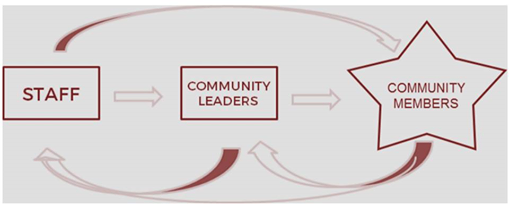TOP 3 Appropriate Approach/Framework
The assigned theme to our group was “Social Enterprises”/”Livelihood” which means that we will be working with entrepreneurs and cooperative members. There are various approaches that can be applied. Here are the top 3 best appropriate (There is no best approach – “case-to-case” basis.) approach: ∧
1. Staff-Leaders-Members approach (Layson & Nisperos, 2016)

First is the “staff-leaders-members” approach. This is appropriate since a cooperative is composed of many members, it would be hard if we, facilitators, will talk to all of them. This is why we will coordinate with the cooperative’s officers or the enterprise’s leaders first to know the basic information – particularly, their common concerns – about their “community”. Then, the officers will talk to the members on what they should do. Through this, the process will be more efficient and easier both to the staff and the stakeholders.
2. Training-Volunteering approach (Hemedez & Virtudes, 2016)

Second is the “training-volunteering” approach. This is appropriate since a training or workshop would help them know basic knowledge and enhance skills. Also, the “volunteering” aspect is very important because the stakeholders must be willing to share their stories and “talents”. Also, cooperative members are used to attending workshops. This approach will also be effective since the members “voluntarily” joined their “communities” – source of livelihood and income. Therefore, this approach is applicable because it will help the stakeholders not only to address their concerns, but it will also develop new knowledge that they can apply in their lives.
3. News-worthiness approach (Palle & Zaldua, 2016)

Third is the “news-worthiness” approach. When writing a story, the first thing we need to ask is: “Is it news-worthy?” Why? It is because what’s the purpose of writing it if it will not benefit the people. So, before facilitating the “writing” process, first we need to “filter” the stories of the stakeholders. There can be lots of stories or concerns, but the question is: Do other people need to know about this? If yes, then why? This is what makes this approach applicable to our case. We will encounter various stories from the stakeholders, but it is crucial which among these stories should we focus on or which among these concerns should we help them address.
There are many other approaches and framework that can be used. These approaches are only some of those. It is important to choose the most appropriate so that the communication between the facilitators and stakeholders would be greatly established which will then result to a positive outcome.
